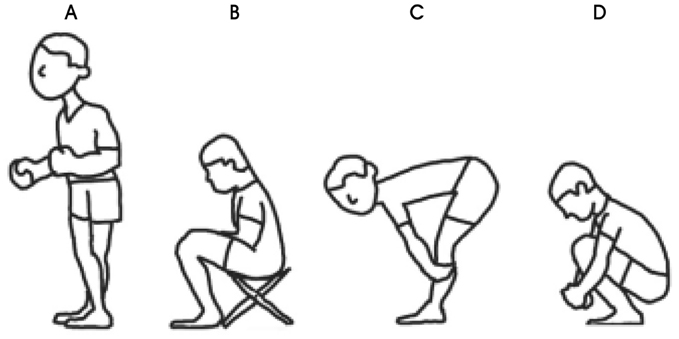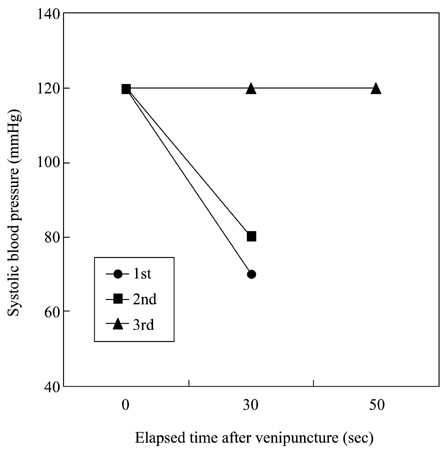J Clin Neurol.
2006 Mar;2(1):66-69. 10.3988/jcn.2006.2.1.66.
Successful Treatment of Vasovagal Syncope Due to Blood-Injury Phobia by Physical Maneuvering
- Affiliations
-
- 1MTV (Migraine, Tinnitus and Vertigo) Clinic, Oh Neurology Center, Daegu, South Korea. byung_in@hotmail.com
- 2Department of Neurology, School of Medicine, Ajou University, Suwon, South Korea.
- 3Department of Neurology, National Health Insurance Corporation Ilsan Hospital, South Korea.
- KMID: 2287705
- DOI: http://doi.org/10.3988/jcn.2006.2.1.66
Abstract
- Blood-injury phobia may present as a vasovagal syncope in response to the sight of blood or after receiving venipuncture. A 26-year-old man presented with a history of syncope induced by venipuncture. A transcranial Doppler (TCD) scan with monitoring of both heart rate and blood pressure reproduced the syncope and showed it to be vasovagal in nature. Treatment by practicing physical maneuvers, such as leg crossing and muscle tensing, improved the condition of the patient. This case suggests that physical maneuvering is effective in the treatment of blood-injury phobia.
MeSH Terms
Figure
Reference
-
1. Hagopian LP, Crockett JL, Keeney KM. Multicomponent treatment for blood-injury-injection phobia in a young man with mental retardation. Res Dev Disabil. 2001. 22:141–149.
Article2. Accurso V, Winnicki M, Shamsuzzaman AS, Wenzel A, Johnson AK, Somers VK. Predisposition to vasovagal syncope in subjects with blood/injury phobia. Circulation. 2001. 104:903–907.
Article3. Diehl RR, Linden D, Chalkiadaki A, Diehl A. Cerebrovascular mechanisms in neurocardiogenic syncope with and without postural tachycardia syndrome. J Auton Nerv Syst. 1999. 76:159–166.
Article4. Krediet CT, van Dijk N, Linzer M, van Lieshout JJ, Wieling W. Management of vasovagal syncope: controlling or aborting faints by leg crossing and muscle tensing. Circulation. 2002. 106:1684–1689.
Article5. Vogele C, Coles J, Wardle J, Steptoe A. Psychophysiologic effects of applied tension on the emotional fainting response to blood and injury. Behav Res Ther. 2003. 41:139–155.
Article6. Kaufmann H. Syncope. A neurologist's viewpoint. Cardiol Clin. 1997. 15:177–194.7. Weimer LH. Evans RW, editor. Autonomic function. Diagnostic testing in neurology. 1999. Philadelphia: W.B. Saunders;337–365.8. Brignole M, Alboni P, Benditt D, Bergfeldt L, Blanc JJ, Bloch Thomsen PE, et al. Task force on syncope, European Society of Cardiology. Guidelines on management (diagnosis and treatment) of syncope. Eur Heart J. 2001. 22:1256–1306.9. Hellstrom K, Fellenius J, Ost LG. One versus five sessions of applied tension in the treatment of blood phobia. Behav Res Ther. 1996. 34:101–112.
Article10. Smit AA, Hardjowijono MA, Wieling W. Are portable folding chairs useful to combat orthostatic hypotension? Ann Neurol. 1997. 42:975–978.
Article11. van Dijk N, de Bruin IG, Gisolf J, de Bruin-Bon HA, Linzer M, van Lieshout JJ, et al. Hemodynamic effects of leg crossing and skeletal muscle tensing during free standing in patients with vasovagal syncope. J Appl Physiol. 2005. 98:584–590.
Article
- Full Text Links
- Actions
-
Cited
- CITED
-
- Close
- Share
- Similar articles
-
- A case of carotid sinus syncope due to maxillary neoplasm combined with vasovagal syncope
- New Mechanism of Vasovagal Syncope: Trigeminocardiac Reflex
- An anesthetic experience with cesarean section in a patient with vasovagal syncope: A case report
- Controversy in Diagnosis and Treatment of Vasovagal Syncope
- A case of swallow syncope with sinus pause and vasovagal syncope




